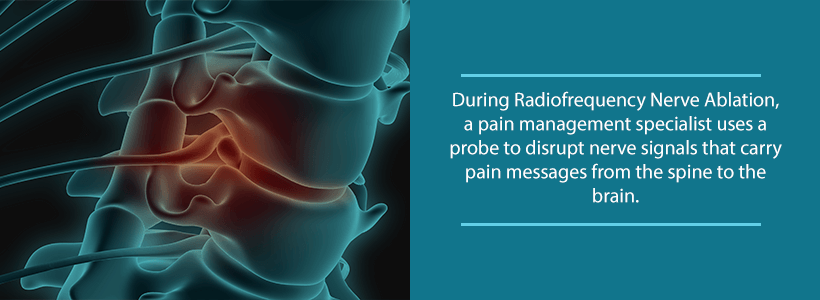What is Facet Nerve Ablation? Those who are seeking degenerative disc disease treatments have probably come across facet nerve ablation in their searches. But, is this an effective method of treating your degenerative disc disease…
Lower back pain affects nearly one-quarter of the population. If you suffer from chronic back pain, then you know how it can impact your life. Pain prevents you from doing the things you love. It keeps you from working and enjoying time with your family and friends.
You’ve tried to deal with the pain on your own. Over-the-counter medications aren’t helping. You don’t want to continually use dangerous and addictive prescriptions. You just want to wake up in the morning without that awful reminder that something is not right with your back.
When managing your chronic pain requires more aggressive treatment, you may need to seek the help of a pain management specialist. These professionals are specifically trained to treat complex, chronic pain.
Use this guide to learn more about pain management specialists, who they help, and the treatments they use to battle chronic pain.
What is a Pain Management Specialist?
Individuals with chronic pain often require a comprehensive approach to treat the condition. Advances in medicine have given doctors and other professionals better insights into the physiology of pain. Moreover, continuous research provides medical professionals with more and more tools to treat pain.
A pain management specialist has special training and experience to treat complex, chronic pain issues. Doctors specializing in pain management undergo extra training to get board-certified in this area. After they complete their medical degree, they enter into a fellowship program. This in-depth program allows for a higher level of study and practice, making them experts in the field.
Fellowship programs usually require at least one year of intensive training. Those entering a pain management fellowship often study anesthesiology, neurology, physiatry, and physical medicine. After the fellowship is completed, they become eligible for board certification in their particular area of pain management.

How is a Pain Management Specialist Different from a Typical Doctor?
Board-certified pain management specialists have a deeper understanding of the complexities of pain. They are better qualified to diagnosis painful conditions accurately. Their vast knowledge of different medications allows for safer and more accurate prescriptions that reduce pain. In addition, they develop skills to perform pain management procedures like the ones mentioned later in this article.
What Back Pain Conditions Can These Specialists Help?
Unlike strains or sprains in the back, chronic back pain is more challenging to treat. When conservative treatments like over-the-counter medications, physical therapy, and changing personal habits aren’t successful, a pain management specialist can help.
Common conditions that can require more aggressive pain management include:
- Failed back surgery syndrome: If there is no relief after one or several back surgeries, the source of the pain may be difficult to pinpoint. It can be due to scar tissue, arthritis, or nerve damage.
- Fibromyalgia: This disorder causes various levels of pain throughout the body. Pain can be widespread or migrate to different regions of the body. Fibromyalgia can be devastating to a person’s physical, mental, and social well-being. There is no known cure for this condition. So, the best course of treatment involves managing your symptoms.
- Neuropathy: Most pain signals start from the source of a trauma and travel through the nerves to the brain. Neuropathy is a distinct type of pain that originates in the nerves. The nerves send faulty pain signals to the brain. This condition can be caused by an injury, diabetes, infection, or substance abuse.

Treatments for Chronic Back Pain
A pain management specialist uses a variety of treatments to help your chronic back pain. Treatments can reduce or even eliminate symptoms. In addition, these treatments may reduce reliance on strong, often addicting, medications. Common pain management techniques for the lower back include:
Epidural Steroid Injections
Intraspinal drug delivery supplies pain and anti-inflammatory medications right to the source of the problem. Injections of corticosteroid medications cause a nerve block, which prevents pain signals from reaching the brain.
A pain specialist numbs the area where the injection takes place. Then the specialist uses live x-ray guidance to inject medications into the epidural space of the spine. This space is the outermost part of the spinal canal, which houses spinal nerve roots and other tissues. The corticosteroid helps to shrink swelling, which can cause pain and pressure around the nerve roots.
Cryoneurolysis
This minimally invasive procedure freezes the outer layer of nerves to disrupt pain signals that would otherwise travel to the brain. During the procedure, a specialist inserts a tiny probe—about the size of an IV needle—into the affected area. At the top of the probe is a tiny ball of ice. It is cooled to around 3 degrees Farenheit by pressurized gas. This intense cold causes a freezer burn on the surface of the nerve. A recent study found patients receiving this treatment experienced a significant reduction in pain for up to six months.
Repeated cryoneurolysis treatments may be necessary as the nerve begins to regenerate.
Radiofrequency Nerve Ablation
Similar to cryoneurolysis, this procedure uses a probe to disrupt the nerve’s pain signals. Instead of using cold, however, radio frequency waves heat the tip of the probe. Using live x-rays, the specialist numbs the affected nerves. Then, your doctor will create a lesion on the nerve with the heated probe.
This minimally invasive procedure usually takes around an hour. Patients often return home the same day. However, pain relief may take up to 10 days to reach full impact.

Spinal Cord Stimulation
By inserting a spinal cord stimulator (SCS) into the back, it helps to mask pain signals before they can reach the brain. Similar to a pacemaker used in the heart, an SCS delivers electrical pulses to the spinal cord. The pulses modify the way in which your nerves dispatch pain signals to the brain.
Pain specialists use a two-stage process for spinal cord stimulation. The initial, trial SCS determines if this procedure will benefit you in the long run. The trial phase usually lasts from 4 to 7 days. Then you will return to the doctor’s office to discuss any relief of symptoms. If the trial stage shows a significant decrease in pain, a permanent SCS will be implanted.
This procedure involves placing electrode leads into the affected site. Specialists use small incisions to reach these areas. A small part at the back of your vertebrae is removed to make room for the leads. The leads are then secured with sutures in the epidural space.
Once the leads are secured, wires are tunneled through the back and attached to the pulse generator. Your doctor will insert the device into the skin just below the waistline. Once your doctor has connected everything, he or she will close the incision.
The goal of spinal cord stimulation is a 50 to 70% reduction in pain. The procedure doesn’t work for everyone. This is why the trial stage is necessary. Some studies show long-term pain relief in up to 80% of patients.
Finding Treatment for Your Chronic Back Pain
All the treatment options for chronic pain can be overwhelming. You just know you’re dealing with pain and you want it to go away.
Consulting with our experts at Orthopedic & Laser Spine Surgery may be the game changer for managing your chronic pain. Our award-winning surgeons and medical staff specialize in pinpointing the source of your pain. Using the latest research, technology, and treatments, we help people, just like you, who struggle with pain every day.
The first step to successfully managing your pain is setting up an appointment. Don’t hesitate to find out how our wide range of treatments can help you get your life back.

